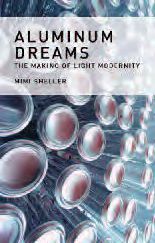SEJournal Online is the digital news magazine of the Society of Environmental Journalists. Learn more about SEJournal Online, including submission, subscription and advertising information.

BookShelf
"Aluminum Dreams: The Making of Light Modernity"
By Mimi Sheller
MIT Press, $29.95
Reviewed by JENNIFER WEEKS
What is the most essential material for modern living? Most people would probably choose oil or plastics. But Drexel University sociologist Mimi Sheller has a different answer: aluminum.
“Aluminum Dreams” tells the story of this lightweight metal, and shows how corporations have marketed it as a symbol of speed, lightness and progress.
Sheller also describes aluminum’s darker side – the heavy environmental impacts of bauxite mining and hydropower development (many rivers have been dammed in the United States and elsewhere to provide the huge quantities of power needed for aluminum smelting).
In her words, aluminum is “a superficially lightweight topic with a surprisingly heavy history.”
Aluminum is everywhere in our daily lives: It is used in buildings, cars, airplanes, electrical transmission systems, packaging, appliances, and many consumer goods. Its ubiquity reflects aluminum’s useful qualities. It is lighter than many other metals. It is extremely malleable, conducts heat, cold, and electricity well, and it resists corrosion.
When two 23-year-old researchers (one French, one American) simultaneously discovered an electrolytic process for smelting aluminum from bauxite ore in 1886, they triggered a shift from the first industrial revolution – powered by coal, iron and steam – to a second industrial revolution based on electricity, lightweight metals, and later, plastics and synthetic fibers.
Sheller calls this new age “light modernity.” Using commercial ads, Sheller shows how companies such as Alcoa, Bohn and Kaiser marketed aluminum goods as symbols of a bright future where things were smooth, fast and streamlined. Some products that date back as far as the 1930s have become icons of 20th century design, from Airstream trailers to consumer goods such as rounded toasters and school lunch boxes. In the 1960s and 70s consumer interest waned, and mass-produced goods like aluminum siding came to be seen as artificial and disposable.
But now aluminum is resurging. Design magazines such as Dwell have revived the idea of prefab housing, and many green buildings contain recycled aluminum components, which help builders earn LEED points.
Turning to aluminum’s dark side, Sheller surveys the global impacts of bauxite mining and smelting. Key supplier countries such as Jamaica, Suriname, Guinea and India have struggled to win royalty payments and benefits from multinational companies. Indigenous countries have been displaced for mines and dam construction. Mined-out areas are marked by “deforested mountains and lakes of red mud.” Today, Guinea is one of the world’s largest bauxite producers and also one of the world’s poorest countries.
With this record, is aluminum really a green material?
On one hand, it reduces weight in cars and planes, which saves fuel. It also is very recyclable: Producing soda cans from recycled aluminum uses only about 5 percent of the energy required to make them from virgin material.
But many aluminum products are not recycled, and Sheller argues that the industry’s continuing investments in primary mining and smelting are far larger than the resources companies devote to recycling.
Sheller’s conclusions are fairly obvious: Modern societies should use fewer resources, recycle more of them, and pay more attention to the impacts of resource extraction.
Her writing can be clunky. She creates a choppy effect by overusing quotation marks for information that could be paraphrased. But in spite of these flaws, “Aluminum Dreams” is a timely look at a material that is pervasive in our lives. And for maximum impact, read it on your shiny MacBook Air or iPhone – made with recycled aluminum.
Jennifer Weeks is a Boston-based freelancer and a former SEJ board member.
* From the quarterly newsletter SEJournal, Summer 2014. Each new issue of SEJournal is available to members and subscribers only; find subscription information here or learn how to join SEJ. Past issues are archived for the public here.












 Advertisement
Advertisement 



